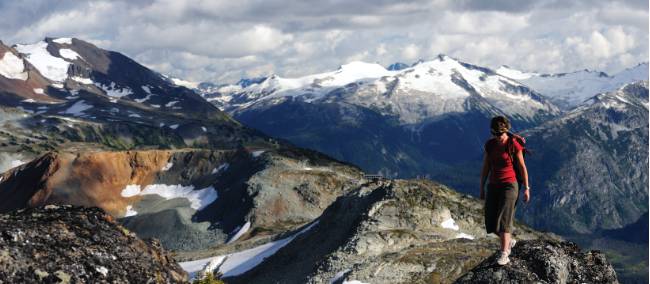
Alpine hiking high above the Whistler Valley | Tourism Whistler/Steve Rogers
By Robin Esrock
If you love the outdoors, chances are you love the mountains. As a force of nature, soaring peaks have a way of stirring the soul. Ansel Adams, the famed photographer and environmentalist, captured it perfectly: “No matter how sophisticated you may be, a large granite mountain cannot be denied – it speaks in silence to the very core of your being.” It’s no accident that many of our itineraries take place in and among Canada’s magnificent mountain ranges. Let’s learn more about them:
The Saint Elias Range
Stretching across northwestern British Columbia, The Yukon and into Alaska, the St Elias Mountains tower over rock, tundra and icefields. It’s a range that includes some of the biggest peaks in North America, including Canada’s tallest peak, Mount Logan, as well as Mount St Elias and Mount King, which all exceed 5200m (17,000ft). Here, you’ll also find the world’s most extensive ice fields outside of the polar ice caps, as well as the Wrangell Volcanic Field, which encompasses over a dozen active shield volcanoes and one of the largest active volcanoes in the world.

The Coast Mountains
Further south, the Pacific Ocean buttresses the Coast Mountain Range, a rocky spine that runs all the way from Vancouver to the Great Bear Rainforest of northern British Columbia. Coastal peaks overlook fjords that rival Norway for their beauty, attracting climbers, hikers and rafters in summer. In winter, skiers from around the world beeline for the continent’s biggest ski resort, Whistler. The result of the collision of continental and ocean plates is that the Coast Mountains are made up of 300-million-year-old rock. The range connects with other mountains to reach as far as Mexico, although the ridge elevation drops the further south you go. The scenic fjords, clear waters and lush valleys are the direct result of glacial action. As you hike the Coast Mountains, explore the ridges, rainforest, glacier lakes and waterfalls between Vancouver, Squamish and Whistler. You can also combine the Coast Mountains with the next range.

The Canadian Rockies
The jewel in Canada’s scenic crown, no other range in the country soaks up the attention (and visitor numbers) of the Canadian Rockies in southern Alberta. Supported by the iconic mountain towns and historic national parks of Banff and Jasper, the Rockies are world-renowned for their sharp peaks, gemstone-coloured lakes, wildflowers, wildlife and pristine wilderness. Tourists flock to the views at Moraine Lake and Lake Louise, while hikers hit the trails to backcountry lodges and hiking huts. Jasper is one of the world’s largest Dark Sky Preserves, while visitors can walk on the stunning Columbia Icefield or drive the scenic Icefields Parkway. Protected as a UNESCO World Heritage Site, the Rockies were shaped 70-80 million years ago by shifting tectonic plates.

The Laurentians
One of the oldest mountain ranges on the planet, the Laurentians don’t loom as large as the peaks out west, but they do provide a four-season playground attracting both outdoor and cultural adventurers. Sprinkled with colourful villages and communities, it is home to Mont Tremblant (the largest ski resort in Quebec), dense boreal forest, rolling hills, over 9000 lakes, and outcrops of ancient Canadian Shield. Stretching roughly from the Gatineau River south to the Saguenay River, the highest peak is Mount Raoul Blanchard, at 1,166 m (3,825 ft). Discover its charms by cycling along Canada’s longest linear pathway, Le P'tit Train du Nord, between the towns of St Jerome and Val David.

The Long Range Mountains
The east coast of Canada is no slouch in the mountain department. The Long Range Mountains extend 500 kilometres up the west coast of Newfoundland, and while they average just 610 metres (2000ft) in altitude, the mountains are often the backdrop for icebergs, rich bird life and traditional fishing villages. The range has been impacted by repeated glaciation, resulting in the beautiful fjords that dominate Newfoundland’s western edge. Encompassing several ecosystems, the Long Range is known for its desolate moss, heath barrens, and stands of dwarf spruce and balsam fir. The range includes the UNESCO World Heritage Site of Gros Morne National Park, with its moon-like Tablelands and the scenic inland freshwater fjord of Western Brook Pond.
Quick Facts:
- Canada’s Biggest Mountain: Mount Logan, located in the St. Elias Mountains of Yukon, is the biggest mountain in Canada by base area. A massive shield volcano popular with climbers, it covers an area of approximately 2,180 square miles (5,700 square kilometres).
- Canada’s Tallest Mountain: Mount Logan is also the tallest mountain in Canada, and at 19,551 feet (5,959 meters) above sea level, it is the second-highest mountain in North America.
- Canada’s Smallest Mountain: Dundas Island in northern British Columbia is technically a table-top mountain, although it sits just 150 feet (46 meters) above sea level.
- Canada’s Most Striking Mountain: Mount Thor, a granite giant located in Auyuittuq National Park in Nunavut, has the world’s greatest vertical drop, with 4,101 feet (1,250 meters) near-vertical cliff face.
Robin Esrock is the bestselling author of The Great Canadian Bucket List.